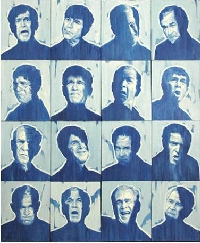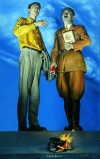 ill. 5.45 a, metadata
ill. 5.45 a, metadata
 ill. 5.45 b, metadata
ill. 5.45 b, metadata
 ill. 5.45 c, metadata
ill. 5.45 c, metadata
 ill. 5.45 d, metadata
ill. 5.45 d, metadata
 ill. 5.45 e, metadata
ill. 5.45 e, metadata
Zhang Chenchu and Mao
Repetitions of the Mao portrait in the work of a much younger artist, Zhang Chenchu 张晨初 (1973–), may illustrate that many a generation of artists in China, even those who hardly knew Mao, the man, during his lifetime, reflect upon being confronted by his portrait in their art. In his 2007 painting series entitled in English Eastern Red Series (东方红系列) which, more literally, would be translated as Red Is the East Series, Zhang presents a set of oil paintings reduced in colors to grey, red, white, and black, presenting Mao at different ages in black and grey before a bright red background. Mao’s portrait is, in each case, strangely shadowed over, except for a small stretch of light (as if a flashlight) in the form of a bar running right through the middle of his face (ill. 5.45a&b).
Even for this generation, who hardly experienced life under Mao, he remains an object of honest engagement, if not devotion. The Eastern Red Series, though it seems to present Mao as persistently negotiated, could not be more different from a series of Bush portraits Zhang Chenchu painted in 2008. This latter series openly ridicules and satirizes Bush in a very direct manner by showing him with rather fatuitous smiles and features (ill. 5.45c).
Even though the Eastern Red Series contradicts or even subverts the standards set for painting Mao during the Cultural Revolution, its intent is not to bring down Mao as standard: the spectacular reduction to harshly contrasting colors of black, red, and white presented here accords quite literally with Zhang’s aim of creating “a perfectly objective historical record of Mao Zedong” as well as to “leave a record of the bitter and harsh phase of red history” (我以我的视觉努力企图恢复对毛泽东形象较完整的客观的历史记述 ... 同时也从侧面反映中国上个世纪艰苦卓绝、 波澜壮阔的红色历程) (DACHS 2009 Zhang Chenchu Writings).
The multiple layers in these negotiations of Mao and his significance for Zhang Chenchu are evident in another Mao series that appeared in 2006. Here, too, the bar of light occurs. But apart from that, this consists of a number of Mao’s standard portraits in different (and very warm) colors (ill. 5.45d). The series becomes the reference point to a number of other portrait series of political figures by Zhang: the light bar is used again in his 2006 painting Leaders—Marx, Engels, Lenin, Stalin, Mao (领袖—马恩列斯毛) followed by Leaders One (领袖之一) and Leaders Two (领袖之二), respectively, each of which shows China’s leaders including Zhu De, Liu Shaoqi, Mao Zedong, Hua Guofeng, and Deng Xiaoping, first in color, and in the second version reduced to grey tones, but all with the same “crack-lighting” device applied. In 2007, Zhang created a series entitled Three Great Men: Sun Yatsen, Mao Zedong, Deng Xiaoping (三伟人—孙中山, 毛泽东, 邓小平) that retains the lighting effects but places them this time before a background of straight “Warhol colors”: blue for Sun, yellow for Deng, and—naturally—red for Mao (ill. 5.45e).












































































































